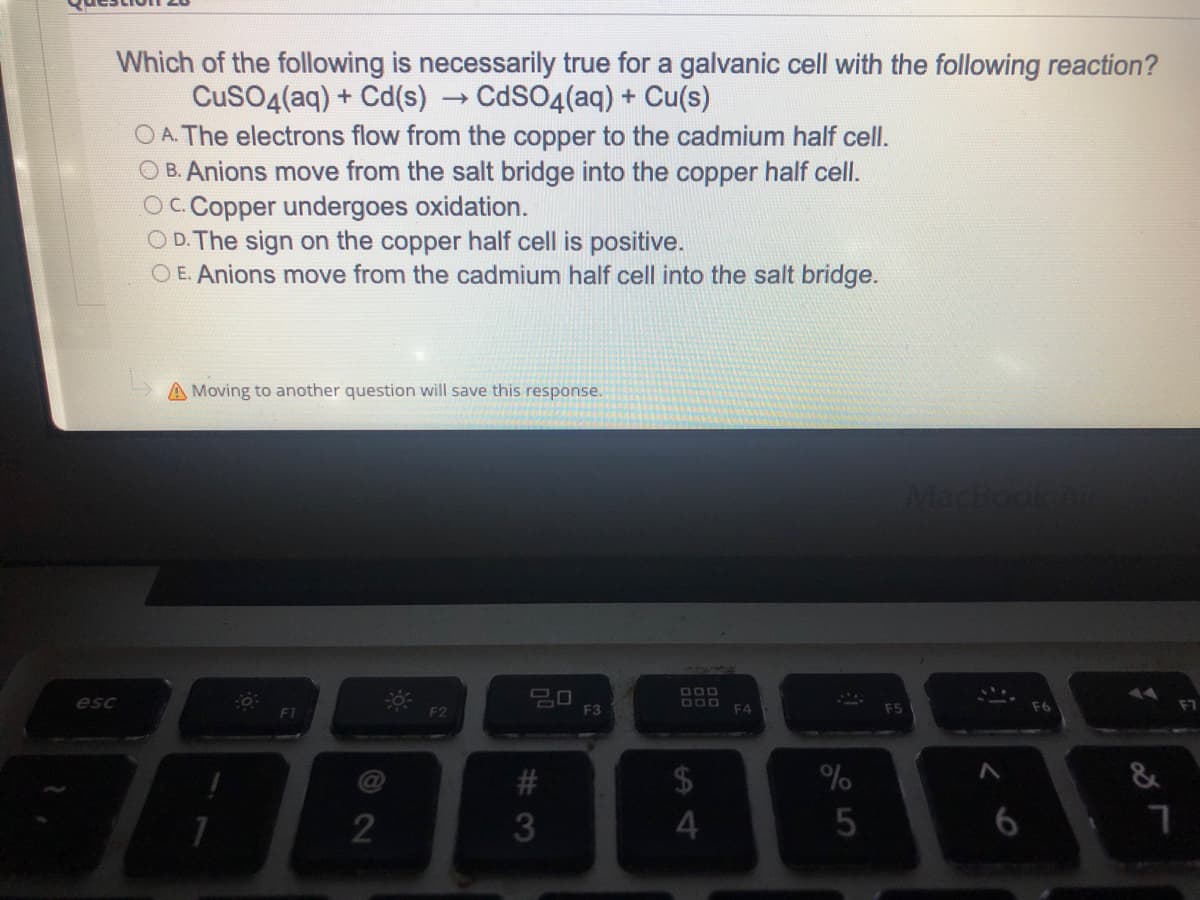Which of the following is necessarily true for a galvanic cell with the following reaction? CuSO4(aq) + Cd(s) ->> CdSO4(aq) + Cu(s) OA. The electrons flow from the copper to the cadmium half cell. OB. Anions move from the salt bridge into the copper half cell. OC. Copper undergoes oxidation. OD. The sign on the copper half cell is positive. O E. Anions move from the cadmium half cell into the salt bridge. A Moving to another question will save this response. MacBook Air 20 F1 F2 esc # ? F3 DOD DOD $ A F4 % 5 13 A 6 F6 881
Which of the following is necessarily true for a galvanic cell with the following reaction? CuSO4(aq) + Cd(s) ->> CdSO4(aq) + Cu(s) OA. The electrons flow from the copper to the cadmium half cell. OB. Anions move from the salt bridge into the copper half cell. OC. Copper undergoes oxidation. OD. The sign on the copper half cell is positive. O E. Anions move from the cadmium half cell into the salt bridge. A Moving to another question will save this response. MacBook Air 20 F1 F2 esc # ? F3 DOD DOD $ A F4 % 5 13 A 6 F6 881
Chemistry & Chemical Reactivity
10th Edition
ISBN:9781337399074
Author:John C. Kotz, Paul M. Treichel, John Townsend, David Treichel
Publisher:John C. Kotz, Paul M. Treichel, John Townsend, David Treichel
Chapter19: Principles Of Chemical Reactivity: Electron Transfer Reactions
Section: Chapter Questions
Problem 60GQ: You want to set up a series of voltaic cells with specific cell potentials. A Zn2+(aq, 1.0 M)| Zn(s)...
Related questions
Question
28

Transcribed Image Text:Which of the following is necessarily true for a galvanic cell with the following reaction?
CuSO4(aq) + Cd(s)
CdSO4(aq) + Cu(s)
OA. The electrons flow from the copper to the cadmium half cell.
OB. Anions move from the salt bridge into the copper half cell.
OC. Copper undergoes oxidation.
OD. The sign on the copper half cell is positive.
O E. Anions move from the cadmium half cell into the salt bridge.
A Moving to another question will save this response.
MacBook Air
20
F2
esc
2
#3
F3
DOD
DOD
$
4
F4
%
5
#j
F6
11
&
7
F7
Expert Solution
This question has been solved!
Explore an expertly crafted, step-by-step solution for a thorough understanding of key concepts.
Step by step
Solved in 3 steps with 1 images

Knowledge Booster
Learn more about
Need a deep-dive on the concept behind this application? Look no further. Learn more about this topic, chemistry and related others by exploring similar questions and additional content below.Recommended textbooks for you

Chemistry & Chemical Reactivity
Chemistry
ISBN:
9781337399074
Author:
John C. Kotz, Paul M. Treichel, John Townsend, David Treichel
Publisher:
Cengage Learning

Chemistry & Chemical Reactivity
Chemistry
ISBN:
9781133949640
Author:
John C. Kotz, Paul M. Treichel, John Townsend, David Treichel
Publisher:
Cengage Learning

Chemistry: An Atoms First Approach
Chemistry
ISBN:
9781305079243
Author:
Steven S. Zumdahl, Susan A. Zumdahl
Publisher:
Cengage Learning

Chemistry & Chemical Reactivity
Chemistry
ISBN:
9781337399074
Author:
John C. Kotz, Paul M. Treichel, John Townsend, David Treichel
Publisher:
Cengage Learning

Chemistry & Chemical Reactivity
Chemistry
ISBN:
9781133949640
Author:
John C. Kotz, Paul M. Treichel, John Townsend, David Treichel
Publisher:
Cengage Learning

Chemistry: An Atoms First Approach
Chemistry
ISBN:
9781305079243
Author:
Steven S. Zumdahl, Susan A. Zumdahl
Publisher:
Cengage Learning


Chemistry
Chemistry
ISBN:
9781305957404
Author:
Steven S. Zumdahl, Susan A. Zumdahl, Donald J. DeCoste
Publisher:
Cengage Learning

Chemistry: Principles and Reactions
Chemistry
ISBN:
9781305079373
Author:
William L. Masterton, Cecile N. Hurley
Publisher:
Cengage Learning